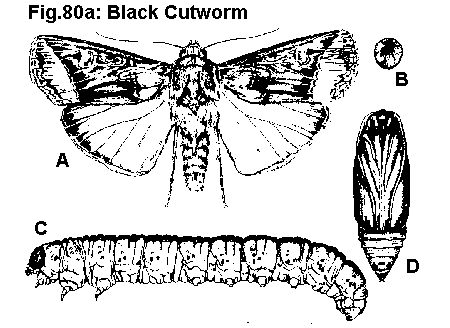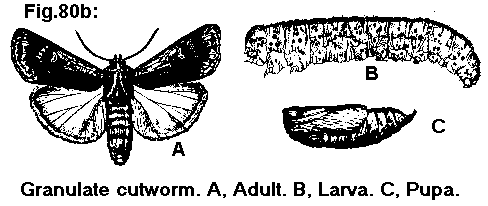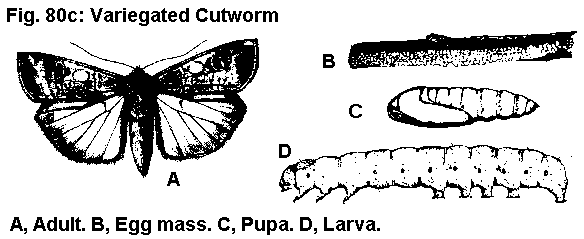
Return to: CFREC Home Page
Adult- When resting, adult cutworm moths hold their wings back in a triangular position. The moths are stocky and have wingspans of about 40 mm. The forewings are dark and mottled or streaked; the hind wings are lightly colored and not marked.
Eggs- The eggs are usually white (becoming darker prior to hatching), round, and 0.5 to 0.75 mm in diameter.
Larva- If disturbed, the larvae usually curl into a C-shaped ball. Cutworms are dull-colored, fat, smooth caterpillars that become about 45 mm when fully grown.
Pupa- Pupae are brown and 15 to 22 mm long.
Fig. 80A: Black Cutworm, Agrotis ipsilon (Hufnagel); Noctuidae, LEPIDOPTERA

Fig. 80B: Granulate cutworm, feltia subterranea (Fabricius); Noctuidae, LEPIDOPTERA

Fig. 80C: Variegated cutworm, Peridroma saucia (Hubner), Noctuidae, LEPIDOPTERA

Distribution- Cutworms are found throughout the United States.
Host Plants- Besides field and vegetable crops, some of the plants attacked by cutworms are aster, carnation, chrysanthemum, dahlia, gladiolus, marigold, nasturtium, pansy, rose, violet and zinnia.
Damage - Many cutworms prefer wilted plant material and cut the plants a night ahead. Stems are chewed off near the soil. Some cutworms climb the host and feed on unopened buds.
Life History- Cutworms are caterpillars that feed on the stems and leaves of young plants and often cut them off near the soil line, hence their common name. Although there are many important species of cutworms, the black, granulate and variegated cutworms are particularly destructive to flowers. Each cutworm differs slightly from the others in details of habits and appearance, but their life histories are generally similar. Adults and larvae are nocturnal and hide during the day but become active on cloudy days. The overwintering forms of cutworms occur in the soil either as pupae or mature larvae. In the spring, the hibernating larvae pupate. Adults begin to appear in the middle of March. Females deposit eggs singly or in clusters, and each female can lay as many as 500 eggs. Under optimum conditions, the eggs hatch in 3 to 5 days, and the larvae develop in 3 to 4 weeks passing through 6 instars. Pupae mature in 2 weeks during the summer and as many as 9 weeks in the fall. Some of the cutworms can produce as many as four generations each year in the southeastern United States.
Cutworms can enter a greenhouse as moths which fly in and deposit eggs. Often eggs, larvae, and pupae gain entry in contaminated soil or on infested plants brought into the greenhouse. Cutworms can be found throughout the year in the greenhouse if a population is established there.
For specific chemical control recommendations, consult the current Cooperative Extension Service publications on ornamental plant pest management.
University of Florida/IFAS Reference to Pest Control Guides